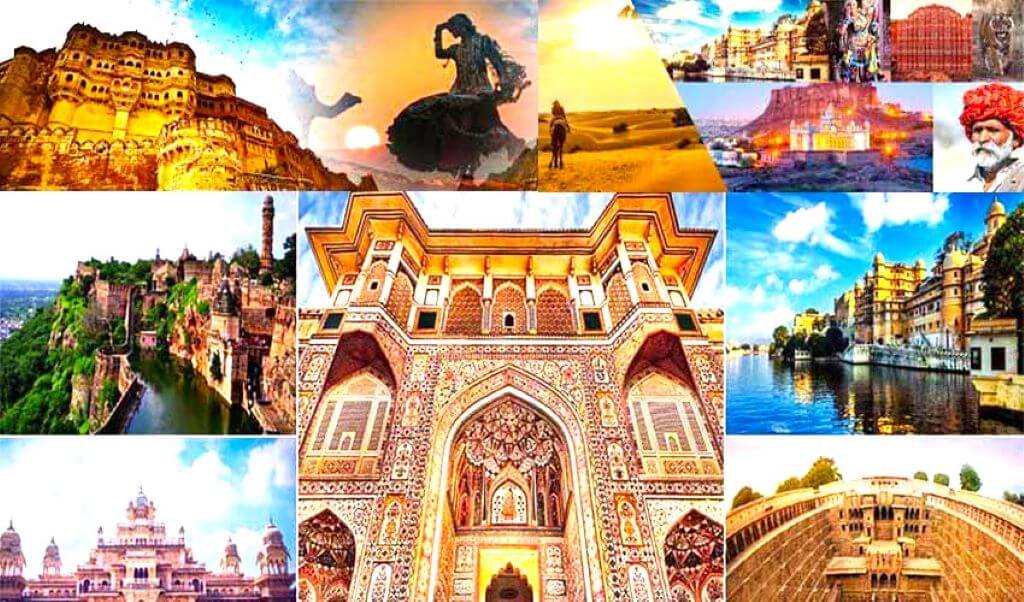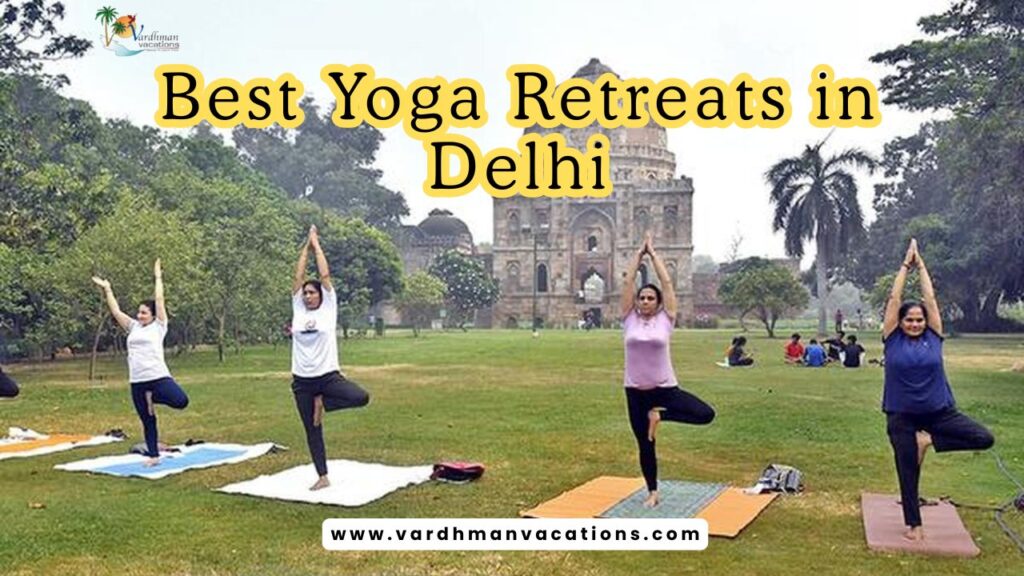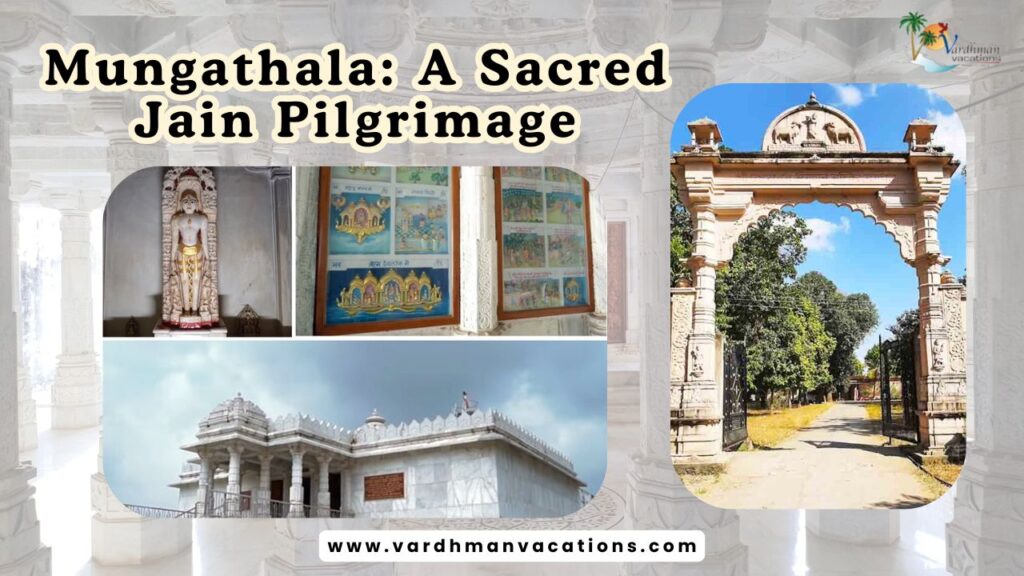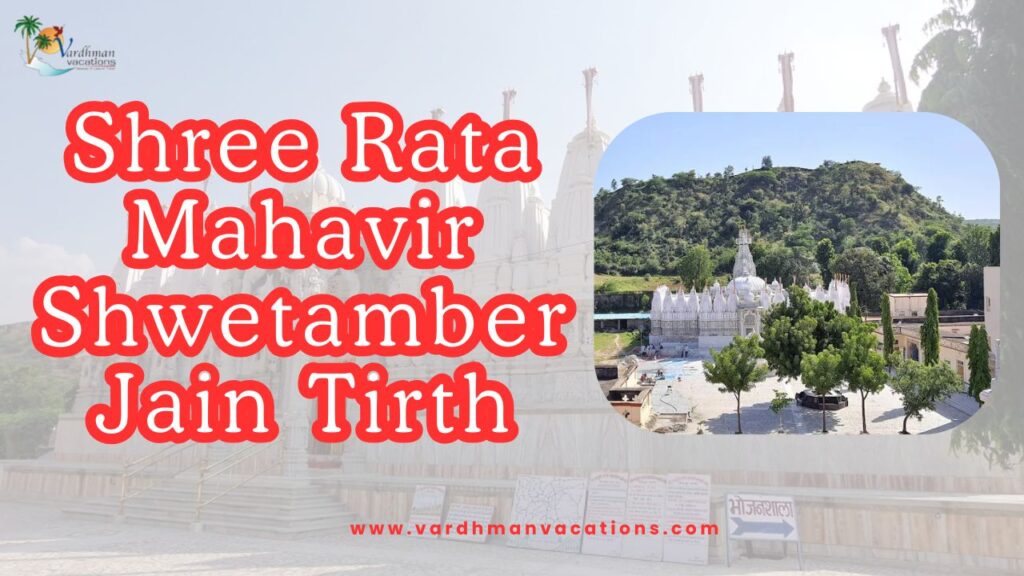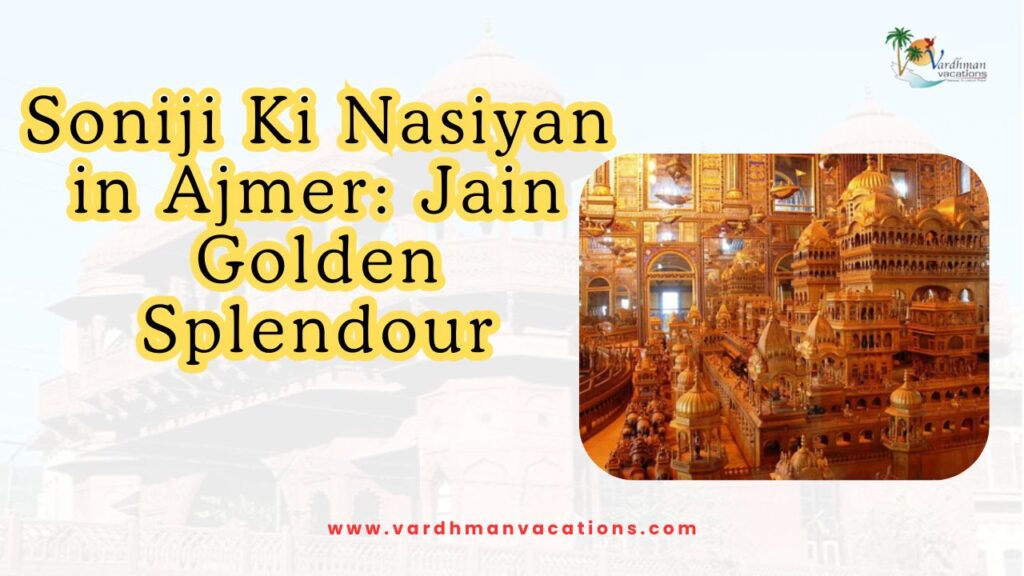Rajasthan, the land of kings, forts, palaces, and deserts, is one of India’s most captivating travel destinations. September is an ideal month to explore the state as the monsoon rains leave the landscape lush and vibrant, while the scorching summer heat begins to subside. From royal cities like Jaipur and Udaipur to offbeat gems like Bundi and Shekhawati, Rajasthan offers a perfect blend of history, culture, adventure, and natural beauty. Whether you want to witness majestic forts, serene lakes, colorful havelis, or wildlife safaris, Rajasthan in September is a traveler’s delight.
Here are some of the most beautiful and captivating places to explore in Rajasthan during September. The post-monsoon season brings cooler weather, greener landscapes, and fewer crowds—making it a perfect time for exploration.
Jaipur – The Pink City
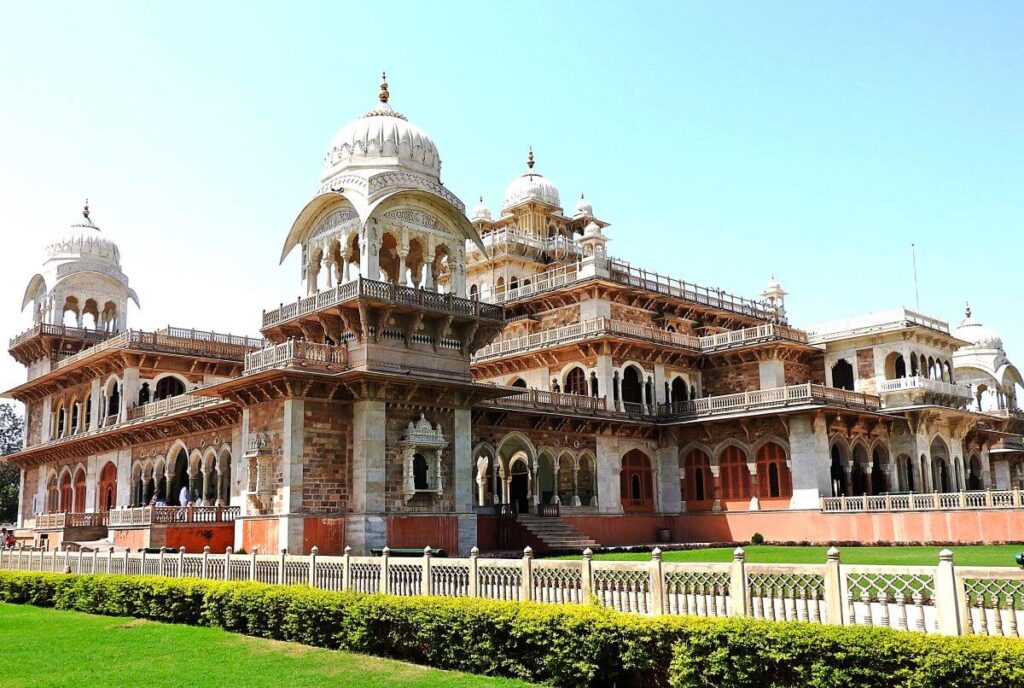
The capital of Rajasthan, Jaipur, famously known as the Pink City, is a vibrant blend of history, culture, and architecture. In September, the city comes alive with a refreshing post-monsoon charm—forts look majestic against cloudy skies, gardens bloom, and the weather becomes more pleasant compared to the scorching summer. Jaipur offers a royal introduction to Rajasthan with its colorful bazaars, grand palaces, and bustling streets.
Tourist Attractions
- Amber Fort & Palace – A stunning blend of Mughal and Rajput architecture, perched on a hill with elephant rides and light shows.
- City Palace – A living palace showcasing Jaipur’s royal heritage and museums.
- Hawa Mahal (Palace of Winds) – Iconic five-story structure with honeycomb windows.
- Jantar Mantar – UNESCO World Heritage Site with astronomical instruments.
- Nahargarh Fort & Jaigarh Fort – Perfect for panoramic sunset views.
- Albert Hall Museum – A treasure of art and history.
Things to Do
- Take an evening light & sound show at Amber Fort.
- Explore Johari Bazaar & Bapu Bazaar for jewelry, textiles, and handicrafts.
- Enjoy authentic Rajasthani thali at Chokhi Dhani or local eateries.
- Go for a hot air balloon ride over Jaipur’s forts and palaces.
- Capture Instagram-worthy shots of the Pink City’s old streets and markets.
How to Reach
- By Air: Jaipur International Airport (12 km from city center) connects to Delhi, Mumbai, Bangalore, etc.
- By Train: Jaipur Junction is well connected by Shatabdi, Rajdhani, and other major trains from metro cities.
- By Road: Excellent highways connect Jaipur with Delhi (270 km / 5–6 hrs), Agra (240 km / 4–5 hrs), and Udaipur (395 km / 7 hrs).
Udaipur – The City of Lakes
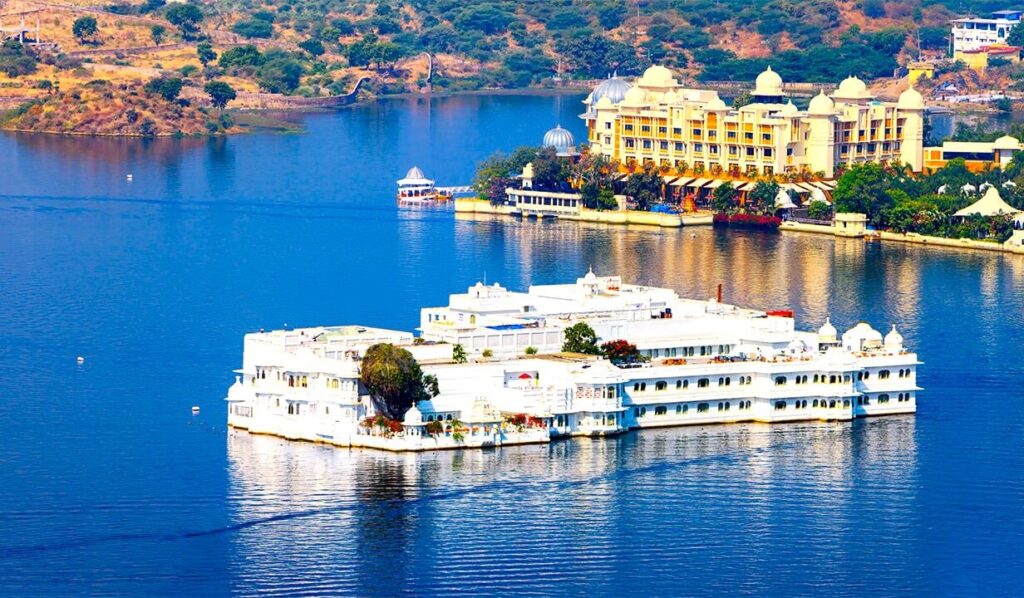
Known as the Venice of the East, Udaipur is one of the most romantic destinations in India. With its shimmering lakes, grand palaces, and the Aravalli Hills surrounding the city, Udaipur becomes especially enchanting in September. The monsoon rains leave the lakes full, the gardens lush green, and the air cool—making it the perfect time to enjoy boat rides, heritage walks, and breathtaking sunsets.
Tourist Attractions
- City Palace – A magnificent palace complex with courtyards, balconies, and panoramic views of Lake Pichola.
- Lake Pichola – Famous for boat rides with stunning views of the City Palace, Jag Mandir, and Lake Palace.
- Jag Mandir & Jag Niwas (Lake Palace) – Historic palaces located on islands in Lake Pichola.
- Sajjangarh (Monsoon Palace) – Known for its hilltop location and dramatic sunset views.
- Fateh Sagar Lake – A popular spot for boating and lakeside cafes.
- Saheliyon Ki Bari – A beautiful garden with fountains and marble pavilions.
- Jagdish Temple – An ancient Hindu temple with intricate carvings.
Things to Do
- Take a sunset boat ride on Lake Pichola for the best city views.
- Explore heritage hotels and rooftop cafes overlooking the lakes.
- Visit the Crystal Gallery inside Fateh Prakash Palace.
- Attend a cultural dance and puppet show at Bagore Ki Haveli.
- Shop for miniature paintings, jewelry, and handicrafts in Hathi Pol Bazaar.
How to Reach
- By Road: Excellent highways connect Udaipur with Jodhpur (250 km), Jaipur (395 km), and Ahmedabad (260 km).
- By Air: Maharana Pratap Airport (22 km from city) connects to Delhi, Mumbai, Jaipur, and Bangalore.
- By Train: Udaipur City Railway Station is linked with Delhi, Jaipur, Ahmedabad, and other cities.
Jodhpur – The Blue City
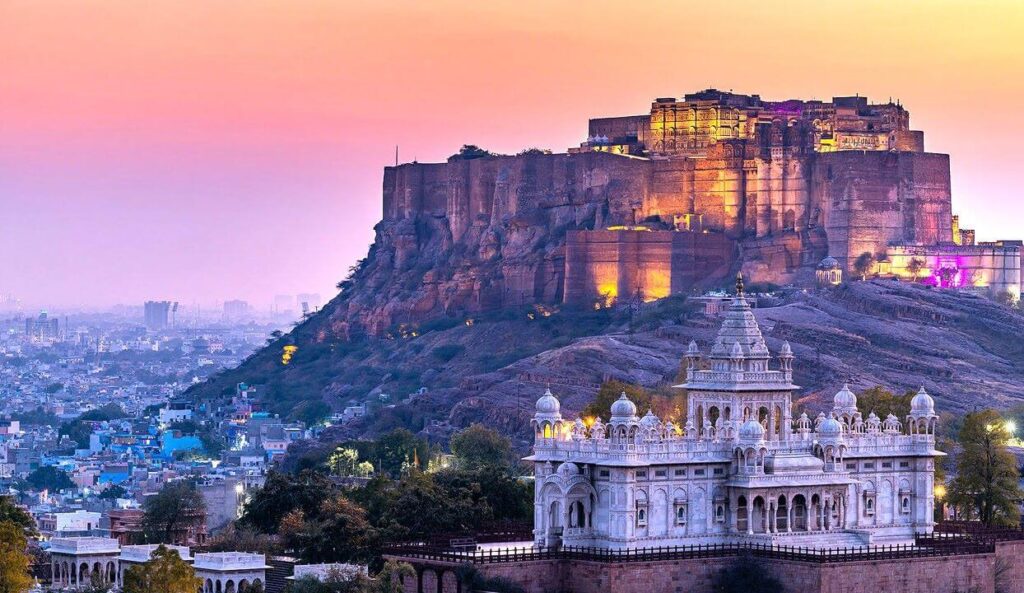
Nicknamed the Blue City for its striking blue-painted houses, Jodhpur is a vibrant mix of history, culture, and desert charm. In September, the city enjoys pleasant weather after the monsoon, making it ideal for exploring massive forts, bustling bazaars, and the colorful streets. With the Mehrangarh Fort towering over the city and the Thar Desert in the backdrop, Jodhpur offers a royal and rustic experience.
Tourist Attractions
- Mehrangarh Fort – One of India’s largest forts, showcasing palaces, museums, and sweeping views of the blue city.
- Umaid Bhawan Palace – A part-hotel, part-museum, and one of the last great palaces built in India.
- Jaswant Thada – A marble cenotaph with intricate carvings, often called the Taj Mahal of Marwar.
- Mandore Gardens – Scenic gardens with cenotaphs, temples, and historic ruins.
- Clock Tower & Sardar Market – Famous for spices, handicrafts, and local shopping.
Things to Do
- Go zip-lining around Mehrangarh Fort for a thrilling experience.
- Take a heritage walk through the blue lanes of old Jodhpur.
- Taste Mirchi Bada, Pyaaz Kachori, and Makhaniya Lassi, Jodhpur’s famous street foods.
- Shop for bandhani textiles, antiques, and handicrafts at local markets.
- Take a camel safari at Osian, a desert town near Jodhpur.
How to Reach
- By Road: Well-connected by highways; Delhi (10 hrs / 600 km), Jaipur (6 hrs / 330 km), Udaipur (5 hrs / 250 km).
- By Air: Jodhpur Airport (5 km from city center) has direct flights from Delhi, Mumbai, Jaipur, and Ahmedabad.
- By Train: Jodhpur Junction is well connected to major Indian cities like Delhi, Jaipur, and Udaipur.
Mount Abu – The Hill Station Retreat

Nestled in the Aravalli Hills, Mount Abu is Rajasthan’s only hill station and a popular retreat from the desert heat. In September, the region transforms into a lush paradise as the monsoon showers leave behind misty mornings, cool breezes, and refreshing greenery. It’s the perfect place for nature lovers, honeymooners, and anyone seeking peace away from the desert plains.
Tourist Attractions
- Dilwara Jain Temples – World-famous marble temples known for their intricate carvings.
- Nakki Lake – A beautiful lake surrounded by hills, ideal for boating and evening strolls.
- Guru Shikhar – The highest peak in the Aravalli range, offering panoramic views.
- Sunset Point – Popular for breathtaking sunset views over the Aravalli Hills.
- Mount Abu Wildlife Sanctuary – Home to leopards, langurs, and rich flora.
Things to Do
- Go boating on Nakki Lake and enjoy the scenic beauty.
- Visit the Dilwara Temples for their stunning craftsmanship.
- Trek or drive to Guru Shikhar for sweeping landscapes.
- Spend a romantic evening at Sunset Point.
- Explore Mount Abu Wildlife Sanctuary for nature trails and wildlife spotting.
How to Reach
- By Road: Well-connected by buses and taxis from Udaipur, Ahmedabad (220 km), and Jaipur (500 km).
- By Air: Nearest airport is Udaipur (185 km), connected to major Indian cities.
- By Train: Abu Road Railway Station (28 km from town) is the nearest railhead with trains from Delhi, Jaipur, and Ahmedabad.
Pushkar & Ajmer – Sacred Towns
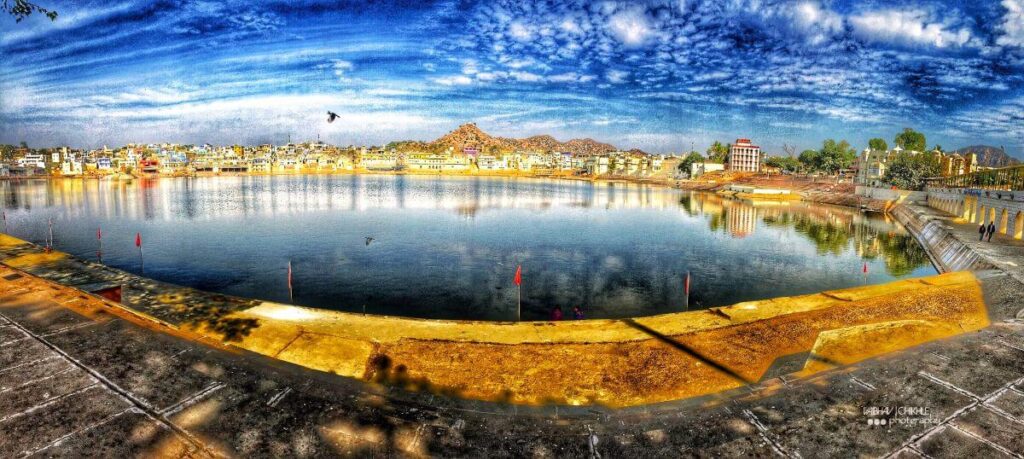
Pushkar and Ajmer are two of Rajasthan’s most spiritually significant towns, each offering a unique cultural and religious experience. In September, after the monsoon, Pushkar Lake is full and the ghats look serene, while Ajmer’s streets are vibrant and lively. These towns make a perfect combination of Hindu and Sufi spirituality, attracting pilgrims and travelers from across the globe.
Tourist Attractions
Pushkar:
- Pushkar Lake & Ghats – A holy lake with 52 ghats where pilgrims take ritual baths.
- Brahma Temple – One of the very few temples dedicated to Lord Brahma in the world.
- Savitri Temple – Located on a hilltop, offering panoramic views of the town.
- Pushkar Bazaar – Famous for handicrafts, jewelry, and Rajasthani textiles.
Ajmer:
- Ajmer Sharif Dargah – A world-renowned Sufi shrine of Khwaja Moinuddin Chishti.
- Adhai Din Ka Jhopra – A 12th-century Indo-Islamic architectural marvel.
- Ana Sagar Lake – A scenic lake ideal for relaxation and boating.
Things to Do
- Attend the evening aarti at Pushkar Lake for a divine experience.
- Take a camel ride through Pushkar’s desert surroundings.
- Shop for leather goods, jewelry, and local handicrafts in Pushkar Bazaar.
- Experience the soulful qawwalis and Sufi music at Ajmer Sharif Dargah.
- Enjoy a sunset view from Savitri Temple in Pushkar.
How to Reach
- By Road: Regular buses and taxis operate between Jaipur, Ajmer, and Pushkar. Jaipur–Ajmer (130 km / 2.5 hrs), Ajmer–Pushkar (15 km / 30 mins).
- By Air: The nearest airport is Jaipur (150 km), with regular flights from major Indian cities.
- By Train: Ajmer Junction is well connected to Delhi, Jaipur, Udaipur, and Mumbai. Pushkar also has a small railway station connected via Ajmer.
Ranthambore – Wildlife Adventure
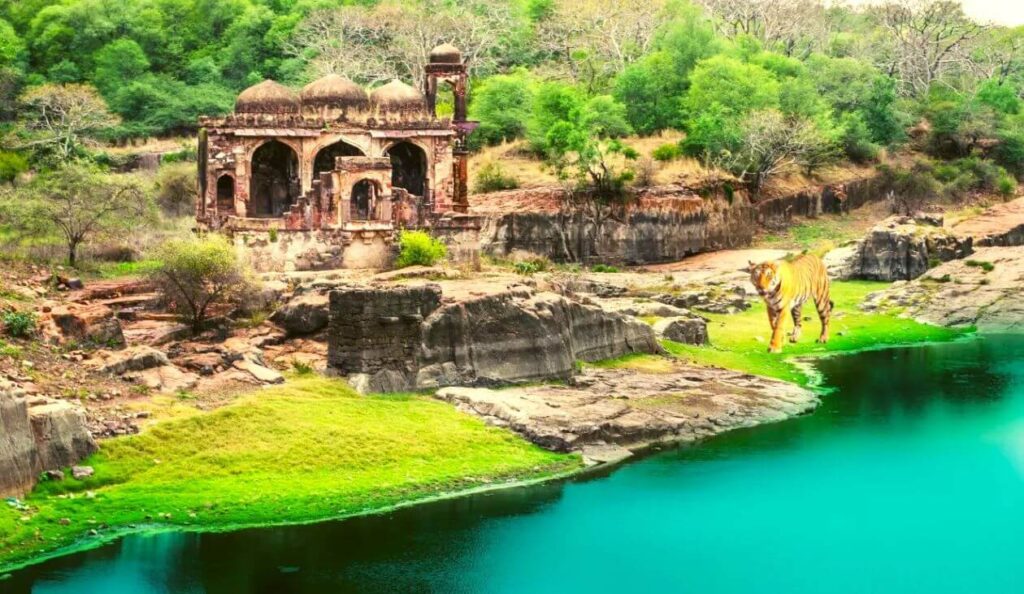
Famed as one of the best places in India to spot Royal Bengal Tigers, Ranthambore National Park is a dream destination for wildlife lovers. In September, the park reopens after the monsoon, and its landscapes are lush and vibrant. The dense greenery, full lakes, and fresh forest air make safaris thrilling, as animals emerge to enjoy the rejuvenated environment. Along with wildlife, Ranthambore also offers a peek into Rajasthan’s history with its ancient forts and ruins.
Tourist Attractions
- Ranthambore National Park – Home to tigers, leopards, sloth bears, marsh crocodiles, and over 300 bird species.
- Ranthambore Fort (UNESCO site) – A 10th-century hilltop fort with temples and panoramic views of the park.
- Padam Talao – A scenic lake often frequented by animals, with Jogi Mahal on its banks.
- Rajbagh Ruins – Ancient palace ruins within the park that add a mystical charm.
Things to Do
- Go on a jeep or canter safari inside Ranthambore National Park.
- Enjoy birdwatching around the lakes and forest trails.
- Visit the historic Ranthambore Fort for history and views.
- Try wildlife photography – tigers, leopards, and marshland birds make perfect frames.
- Stay at jungle resorts for an immersive nature experience.
How to Reach
- By Road: Good connectivity via NH52; Jaipur (4 hrs / 180 km), Delhi (8 hrs / 380 km).
- By Air: Nearest airport is Jaipur (180 km), well connected to Delhi, Mumbai, and Bangalore.
- By Train: Sawai Madhopur Railway Station (14 km from the park) has direct trains from Delhi, Mumbai, and Jaipur.
Bharatpur – Birdwatching Paradise
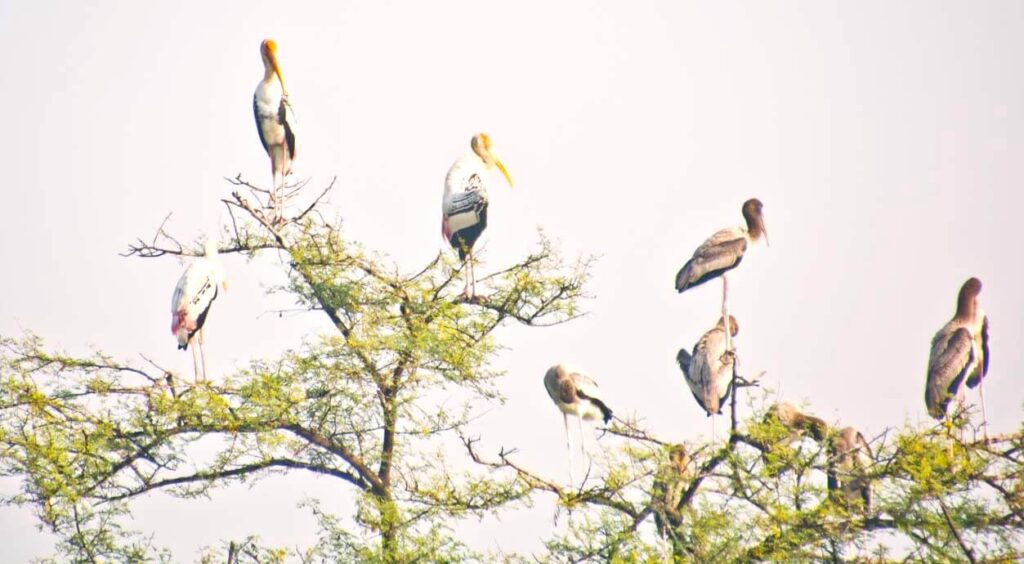
Bharatpur, home to the world-famous Keoladeo Ghana National Park (UNESCO World Heritage Site), is a paradise for birdwatchers and nature lovers. In September, the sanctuary comes alive with lush greenery and the arrival of migratory birds. The weather is pleasant, making it the perfect season to explore wetlands, watch rare species, and enjoy the tranquility of Rajasthan’s natural side.
Tourist Attractions
- Keoladeo Ghana National Park – Famous for migratory birds like Siberian cranes, pelicans, storks, and over 370 bird species.
- Lohagarh Fort – Known as the “Iron Fort,” symbolizing Bharatpur’s royal strength.
- Government Museum – Showcasing Bharatpur’s history, art, and heritage.
- Deeg Palace (nearby) – A beautiful garden palace with fountains and Mughal-style architecture.
Things to Do
- Take a cycle rickshaw ride inside Keoladeo National Park for birdwatching.
- Enjoy wildlife photography of migratory and local bird species.
- Visit Lohagarh Fort for its historic charm.
- Explore Deeg Palace and its monsoon fountains.
- Walk or cycle along the serene trails of the sanctuary.
How to Reach
- By Road: Located on the Delhi–Agra–Jaipur Golden Triangle route; Delhi (220 km / 4.5 hrs), Agra (56 km / 1 hr), Jaipur (186 km / 4 hrs).
- By Air: Nearest airport is Agra (56 km), while Jaipur Airport (186 km) has better connectivity.
- By Train: Bharatpur Junction connects to Delhi, Agra, Jaipur, and Mumbai.
Bikaner – Desert Heritage
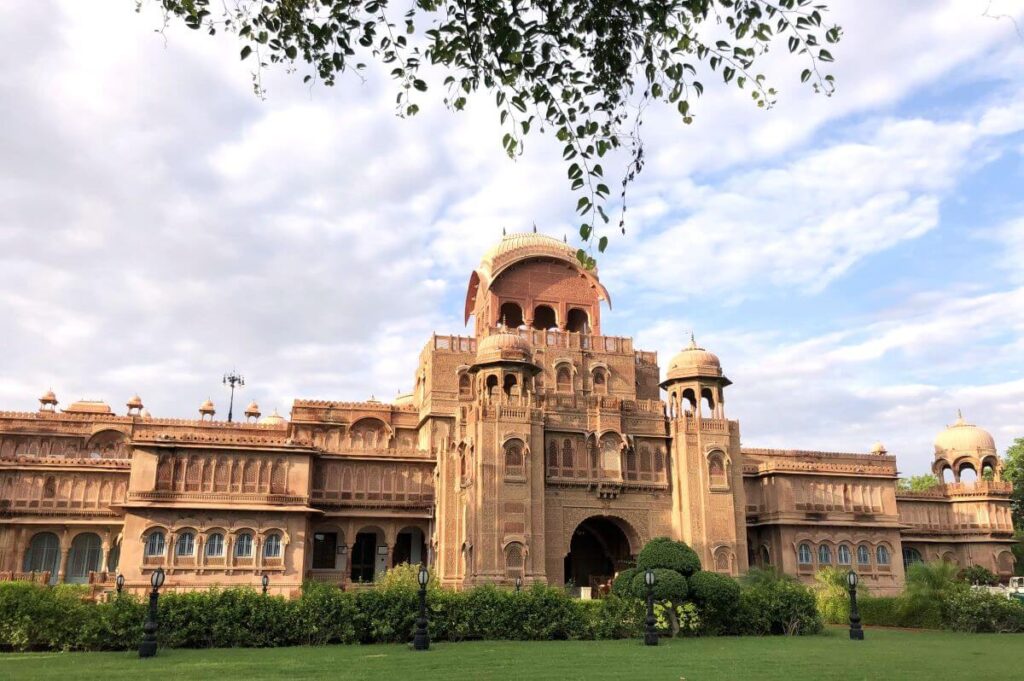
Located in the heart of the Thar Desert, Bikaner is a city steeped in royal heritage, camel culture, and vibrant traditions. Known for its magnificent forts, intricately carved havelis, and delicious snacks, Bikaner offers an authentic desert experience. In September, the climate becomes cooler and more pleasant compared to peak summer, making it an ideal time to explore the city’s desert charm and historical treasures.
Tourist Attractions
- Junagarh Fort – An architectural marvel with ornate palaces, temples, and courtyards.
- Karni Mata Temple (Deshnok Temple) – Famous worldwide for its population of sacred rats.
- Lalgarh Palace – A stunning Indo-Saracenic style palace, now partly a heritage hotel.
- Bhandasar Jain Temple – Known for its exquisite paintings and mirror work.
- National Research Centre on Camel – A unique institute showcasing Rajasthan’s “Ship of the Desert.”
Things to Do
- Take a guided tour of Junagarh Fort to explore its rich history.
- Visit the Camel Breeding Farm and enjoy camel rides.
- Try Bikaneri Bhujia and Rasgulla, the city’s famous delicacies.
- Shop for lac bangles, leather items, and embroidered fabrics in local markets.
- Attend evening folk music and dance shows for a cultural experience.
How to Reach
- By Road: Well-connected via highways; Delhi (480 km / 9 hrs), Jaipur (330 km / 6 hrs), Jodhpur (250 km / 5 hrs).
- By Air: Nearest airport is Jodhpur (250 km); Jaipur (330 km) has better connectivity.
- By Train: Bikaner Junction has direct trains from Delhi, Jaipur, Jodhpur, and Kolkata.
Bundi – The Hidden Gem
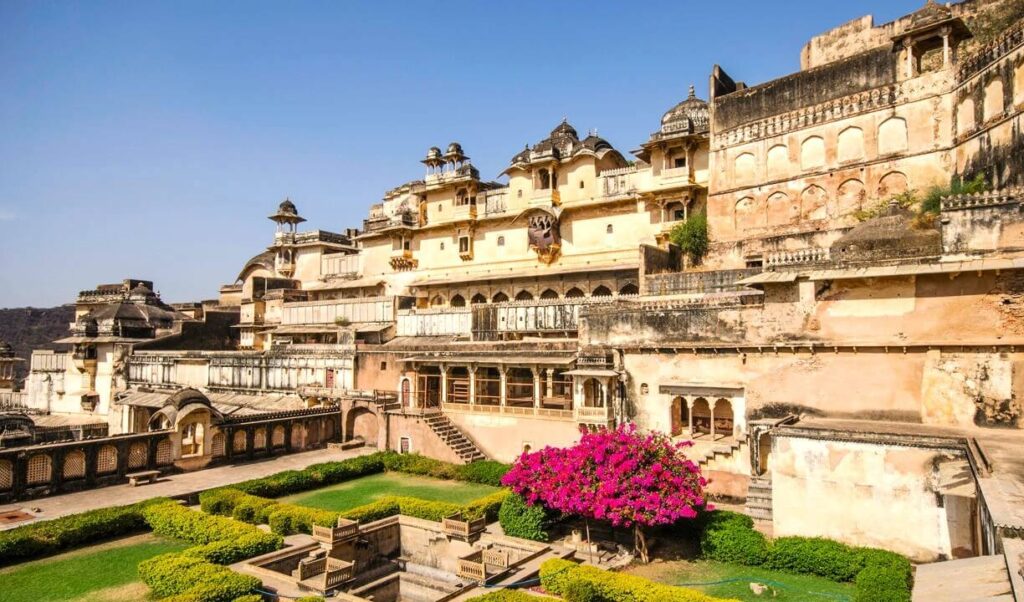
Often overlooked by mainstream travelers, Bundi is a charming town that offers a glimpse into Rajasthan’s untouched beauty. Known for its magnificent stepwells, fresco-painted palaces, and medieval charm, Bundi feels like a city frozen in time. In September, with the monsoon leaving behind a lush and refreshing aura, the town looks especially enchanting, making it a perfect offbeat destination for history, art, and nature lovers.
Tourist Attractions
- Taragarh Fort – An ancient hillside fort offering panoramic views of the town.
- Garh Palace – Adorned with beautiful murals and Bundi-style paintings.
- Stepwells (Baoris) – Such as Raniji ki Baori, famous for their architectural grandeur.
- Sukh Mahal – A lakeside palace where Rudyard Kipling once stayed.
- Nawal Sagar Lake – A serene waterbody with temples reflecting in its waters.
Things to Do
- Explore Bundi’s stepwells and admire their intricate carvings.
- Visit Garh Palace to witness the Bundi school of painting.
- Stroll around the blue-painted old town for its rustic charm.
- Hike up to Taragarh Fort for history and stunning sunset views.
- Take a peaceful boat ride at Nawal Sagar Lake.
How to Reach
- By Road: Bundi is well-connected by buses and taxis; Kota (35 km / 1 hr), Jaipur (210 km / 4.5 hrs), Udaipur (275 km / 5 hrs).
- By Air: Nearest airport is Jaipur (210 km), with regular domestic and international flights.
- By Train: Bundi Railway Station connects to Kota, Jaipur, and Delhi.
Chittorgarh – The Land of Valor
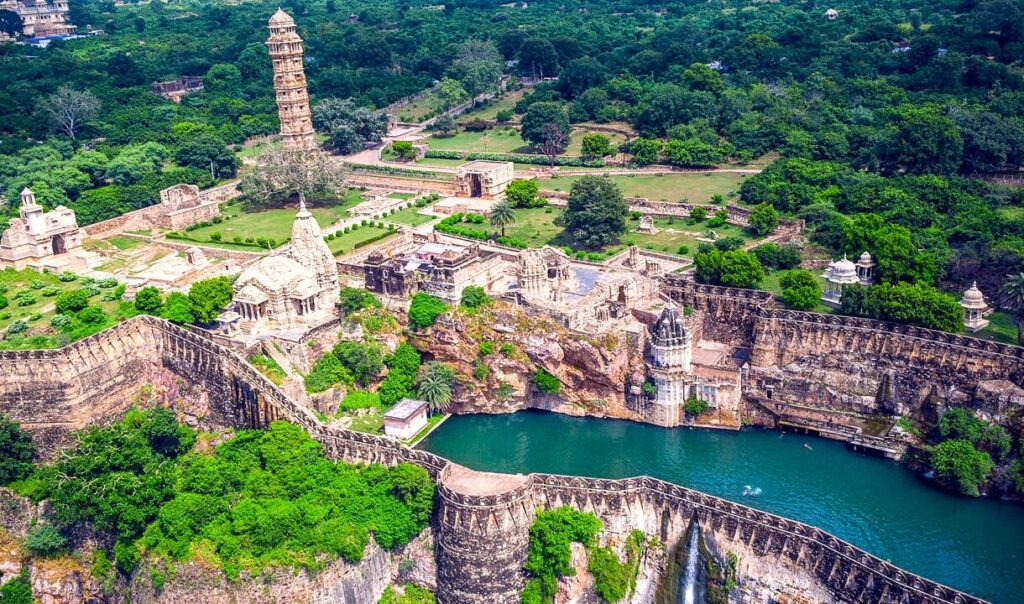
Synonymous with tales of courage, sacrifice, and Rajput pride, Chittorgarh is home to the largest fort complex in India – the Chittorgarh Fort (UNESCO World Heritage Site). The city is steeped in legends of valor, most notably of Rani Padmini and Maharana Pratap. In September, the post-monsoon greenery enhances the fort’s grandeur, and the weather is more pleasant for exploring its sprawling heritage.
Tourist Attractions
- Chittorgarh Fort – Spread over 700 acres, featuring palaces, gates, temples, and towers.
- Vijay Stambh (Tower of Victory) – Built by Rana Kumbha to commemorate victory over Mahmud Khilji.
- Kirti Stambh (Tower of Fame) – Dedicated to Adinath, the first Jain Tirthankara.
- Padmini Palace – Associated with the legendary tale of Rani Padmini.
- Gaumukh Reservoir – A sacred water tank inside the fort.
- Kalika Mata Temple – An ancient shrine within the fort complex.
Things to Do
- Take a heritage walk inside Chittorgarh Fort to explore its many palaces and temples.
- Visit the sound and light show at the fort in the evening.
- Learn about Rajput bravery through local folk tales and guides.
- Enjoy photography of the fort’s stunning architecture and landscapes.
- Explore nearby Bassi Wildlife Sanctuary for a blend of history and nature.
How to Reach
- By Road: Well-connected via NH 27 and NH 76; Udaipur (117 km / 2.5 hrs), Jaipur (310 km / 6 hrs), Kota (160 km / 3 hrs).
- By Air: Nearest airport is Udaipur (70 km), well-connected to Delhi, Mumbai, and Jaipur.
- By Train: Chittorgarh Junction has trains from Jaipur, Udaipur, Ajmer, and Delhi.
Jaisalmer – The Golden City
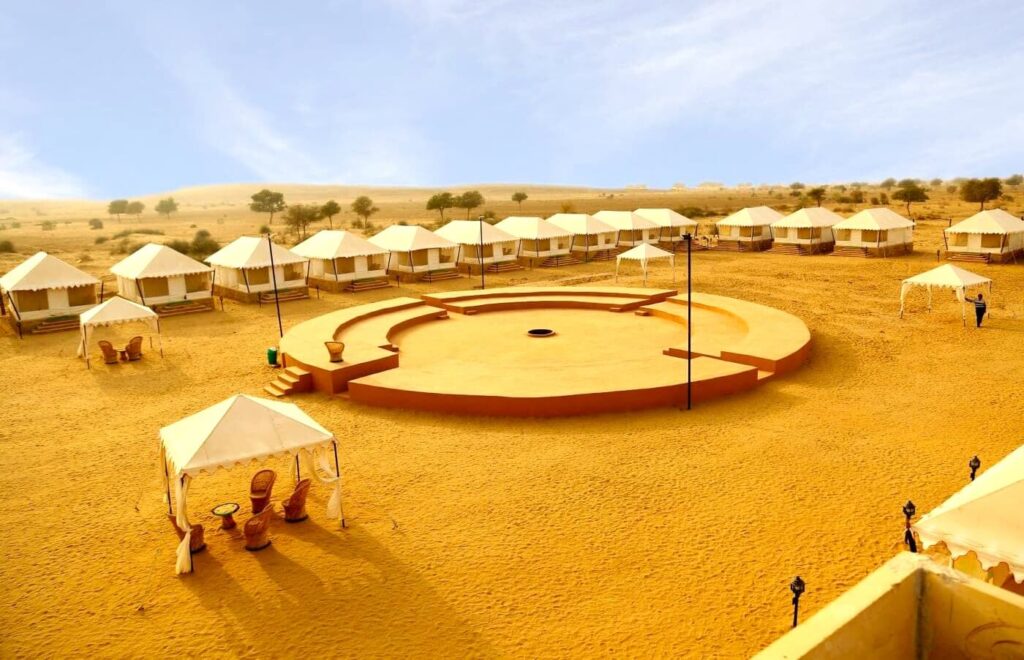
Rising from the heart of the Thar Desert, Jaisalmer is known as the “Golden City” due to its yellow sandstone architecture that glows under the desert sun. With its majestic fort, ornate havelis, and sweeping sand dunes, Jaisalmer is a dream destination for history buffs and desert explorers alike. In September, the desert heat starts easing, and the city slowly gears up for its tourist season, offering a quieter experience before peak winter crowds.
Tourist Attractions
- Jaisalmer Fort (Sonar Quila) – A living fort with palaces, temples, and bustling bazaars.
- Patwon ki Haveli – A cluster of five havelis with exquisite carvings and artwork.
- Salim Singh ki Haveli & Nathmal ki Haveli – Stunning examples of Rajasthani architecture.
- Sam Sand Dunes – Famous for desert safaris, camel rides, and sunset views.
- Gadisar Lake – A peaceful spot with temples and ghats around the water.
- Kuldhara Village – An abandoned, haunted village with intriguing legends.
Things to Do
- Take a camel safari or jeep safari at Sam Sand Dunes.
- Enjoy folk music and Kalbeliya dance under the starlit desert sky.
- Explore the narrow lanes inside Jaisalmer Fort for shopping and local food.
- Visit Gadisar Lake for a sunrise or sunset boat ride.
- Capture the city’s golden glow during sunset photography.
How to Reach
- By Road: Well-connected via highways; Jodhpur (285 km / 5.5 hrs), Bikaner (330 km / 6.5 hrs), Jaipur (560 km / 10 hrs).
- By Air: Nearest airport is Jaisalmer Airport (well-connected seasonally), otherwise Jodhpur Airport (285 km) is the major hub.
- By Train: Jaisalmer Railway Station connects to Delhi, Jaipur, Jodhpur, and other major cities.
Alwar – Gateway to Rajasthan
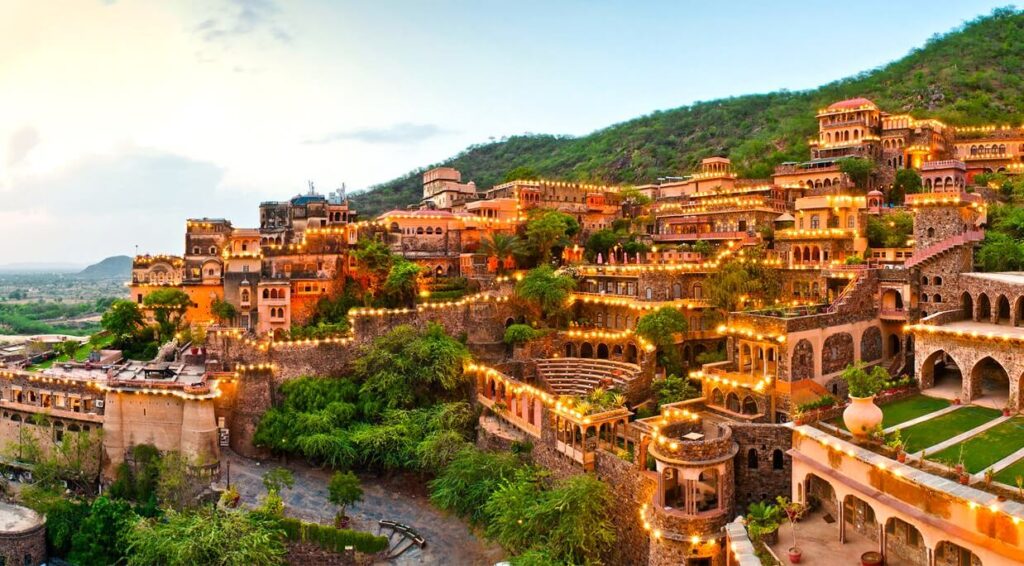
Alwar, located in the northeastern part of Rajasthan, is a charming blend of history, culture, and natural beauty. Known as the gateway to the state, Alwar offers majestic forts, serene lakes, and the Aravalli Hills as a backdrop. Visiting in September is ideal, as the monsoon leaves the surroundings lush and fresh, making it perfect for sightseeing, trekking, and wildlife exploration.
Tourist Attractions
- Bala Qila (Alwar Fort) – A hilltop fort with panoramic views of the city.
- City Palace – A beautiful palace complex housing museums and galleries.
- Sariska Tiger Reserve – A wildlife sanctuary home to tigers, leopards, and diverse flora.
- Siliserh Lake & Palace – A picturesque lake with a palace offering boating and photography.
- Government Museum – Showcasing Alwar’s royal heritage and art.
Things to Do
- Go on a jeep safari at Sariska Tiger Reserve to spot tigers and other wildlife.
- Explore Alwar Fort and its museums for history and architecture.
- Enjoy boating at Siliserh Lake amidst scenic surroundings.
- Discover local bazaars for handicrafts, pottery, and Rajasthani textiles.
- Trek or hike in the Aravalli Hills for nature and panoramic views.
How to Reach
- By Road: Well-connected via highways; Delhi (160 km / 3.5 hrs), Jaipur (150 km / 3 hrs), and Sariska (35 km / 1 hr).
- By Air: The nearest airport is Jaipur (150 km) with good domestic connectivity.
- By Train: Alwar Railway Station connects to Delhi, Jaipur, and other major cities.
Shekhawati Region – Open-Air Art Gallery
The Shekhawati region, often called the “Open-Air Art Gallery of Rajasthan,” is famous for its grand havelis adorned with frescoes and murals. Spanning districts like Jhunjhunu and Sikar, Shekhawati showcases the rich heritage of merchant families who commissioned these artistic masterpieces. In September, the weather is pleasant, and the post-monsoon greenery enhances the colors of the frescoes, making it an ideal time for heritage exploration and photography.
Tourist Attractions
- Mandawa Fort & Havelis – Stunning frescoes and architecture in Mandawa town.
- Nawalgarh Havelis – Known for intricate murals and painted walls.
- Jhunjhunu Fort & Temples – Historic forts and temples with beautiful artwork.
- Khetri Mahal – Also called the Wind Palace, showcasing Rajput architecture.
- Frescoes of Fatehpur & Dundlod – Lesser-known towns with artistic treasures.
Things to Do
- Take a heritage walk through Mandawa, Nawalgarh, and Jhunjhunu to admire frescoes.
- Photograph vibrant murals, havelis, and ornate gates.
- Explore local markets for Rajasthani textiles, jewelry, and handicrafts.
- Learn about the history of Shekhawati merchants and architecture from guides.
- Enjoy folk music and cultural shows in select towns.
How to Reach
- By Road: Well-connected via NH52 and state highways; Jaipur (200 km / 4 hrs), Delhi (270 km / 5 hrs).
- By Air: Jaipur Airport (200 km) is the nearest major airport.
- By Train: Jhunjhunu and Nawalgarh have railway stations connected to Jaipur and Delhi.
Nagaur – Forts and Festivals
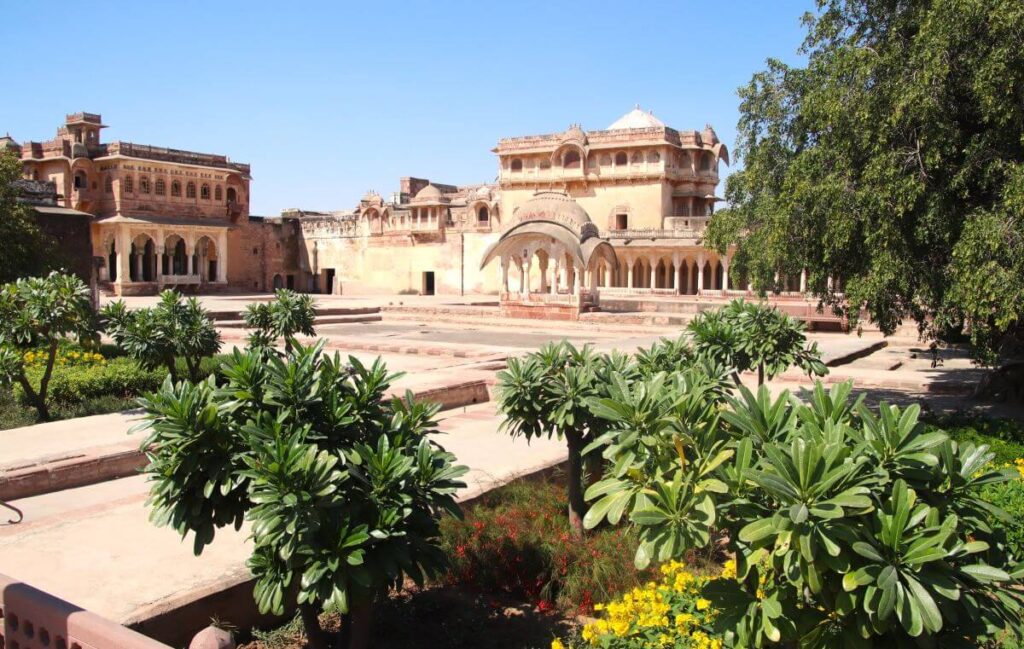
Nagaur, located between Jodhpur and Bikaner, is known for its historical forts, vibrant culture, and annual cattle fair. In September, the weather is pleasant, and the city offers a mix of history, architecture, and local traditions. The Nagaur Fort, with its impressive Rajput-Mughal architecture, stands as the centerpiece of the town and draws history enthusiasts and travelers looking for offbeat destinations in Rajasthan.
Tourist Attractions
- Nagaur Fort – A majestic fort with palaces, temples, and Mughal-style architecture.
- Khinvsar Village – Known for local culture and desert experiences.
- Dargah of Khwaja Moinuddin – A peaceful Sufi shrine in Nagaur.
- Annual Nagaur Cattle Fair – One of the largest livestock fairs in India, held in winter but the town remains culturally rich year-round.
Things to Do
- Explore Nagaur Fort, its palaces, gates, and temples.
- Visit local markets for Rajasthani handicrafts and textiles.
- Take a heritage walk in old Nagaur town.
- Enjoy traditional Rajasthani cuisine in local eateries.
- Experience folk music and local storytelling.
How to Reach
- By Road: Well-connected via highways; Jaipur (145 km / 3 hrs), Jodhpur (240 km / 4.5 hrs), Bikaner (140 km / 3 hrs).
- By Air: Jaipur Airport (145 km) is the nearest major airport.
- By Train: Nagaur Railway Station connects to Jaipur, Jodhpur, and Bikaner.
Mandawa – The Artistic Town of Shekhawati
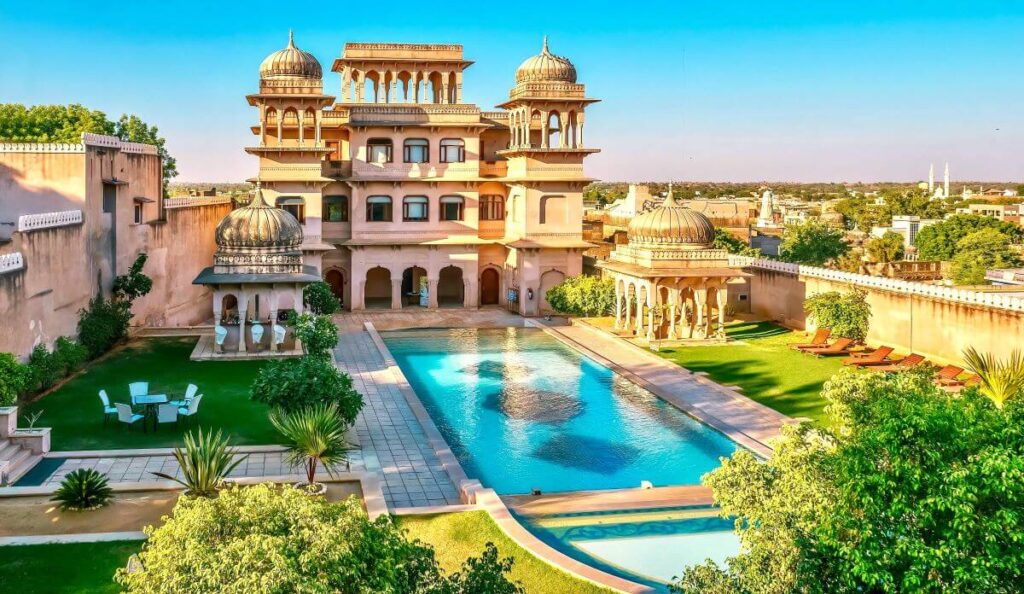
Mandawa, located in the Shekhawati region, is often called the “Open-Air Art Gallery of Rajasthan” because of its magnificent havelis adorned with intricate frescoes and murals. Visiting in September is ideal, as the post-monsoon weather makes exploring the town’s vibrant streets, historic buildings, and artwork comfortable and picturesque. Mandawa is perfect for travelers interested in art, history, and photography.
Tourist Attractions
- Mandawa Fort – A 18th-century fort with beautiful frescoes and royal architecture.
- Hanuman Prasad Goenka Haveli – Famous for its colorful murals and ornate decorations.
- Jhunjhunwala Haveli – Another classic example of Shekhawati artistry.
- Mandawa Bazaar – Bustling market for handicrafts, textiles, and local souvenirs.
- Chokhani Haveli – Known for its exquisite paintings and carvings.
Things to Do
- Take a heritage walk to explore Mandawa’s forts and havelis.
- Photograph the intricate frescoes, murals, and colorful streets.
- Shop for Rajasthani textiles, jewelry, and handicrafts at local bazaars.
- Learn about Shekhawati merchant history and architecture from local guides.
- Attend any folk cultural performances if available.
How to Reach
- By Road: Well-connected via state highways; Jaipur (200 km / 4 hrs), Delhi (270 km / 5 hrs), Jhunjhunu (20 km / 30 mins).
- By Air: Jaipur Airport (200 km) is the nearest major airport.
- By Train: Mandawa has a nearby station at Jhunjhunu (20 km) connecting to Jaipur and Delhi.
Final Thoughts
Rajasthan in September is a perfect blend of pleasant weather, lush landscapes, cultural vibrancy, and royal grandeur. From the royal palaces of Jaipur and Udaipur to the desert landscapes of Jaisalmer and Bikaner, and from serene lakes to historic forts, the state offers an unforgettable journey for every traveler. Whether you’re an adventure seeker, a history enthusiast, or a culture lover, Rajasthan promises a memorable experience in September.
FAQ About Rajasthan
The ideal time to visit Rajasthan is September to March, when the weather is cooler and comfortable for sightseeing, desert safaris, and outdoor activities.
Yes! September marks the post-monsoon season, leaving the landscape green and refreshing. The temperatures are moderate, making it perfect for exploring forts, lakes, and wildlife.
Some top destinations include Jaipur, Udaipur, Jodhpur, Jaisalmer, Ranthambore, Mount Abu, Pushkar & Ajmer, Bikaner, Bundi, Shekhawati, and Alwar.
Absolutely! Ranthambore National Park and Sariska Tiger Reserve reopen in September after monsoon, offering a great opportunity for tiger and wildlife spotting.
Visitors can enjoy heritage walks, desert safaris, camel rides, lake boat rides, photography, shopping for handicrafts, visiting forts and havelis, and experiencing local folk culture.
Rajasthan is well-connected by air, rail, and road. Major airports include Jaipur, Udaipur, Jodhpur, and Jaisalmer. Trains connect most cities, and buses or taxis are ideal for local travel.
September is off-peak for some desert areas like Jaisalmer and Bikaner, so travelers can enjoy a more relaxed experience. Popular cities like Jaipur and Udaipur may see moderate crowds.
Pack light cotton clothes, a light jacket for evenings, comfortable shoes, sunglasses, hat, sunscreen, and camera for sightseeing and desert safaris.

